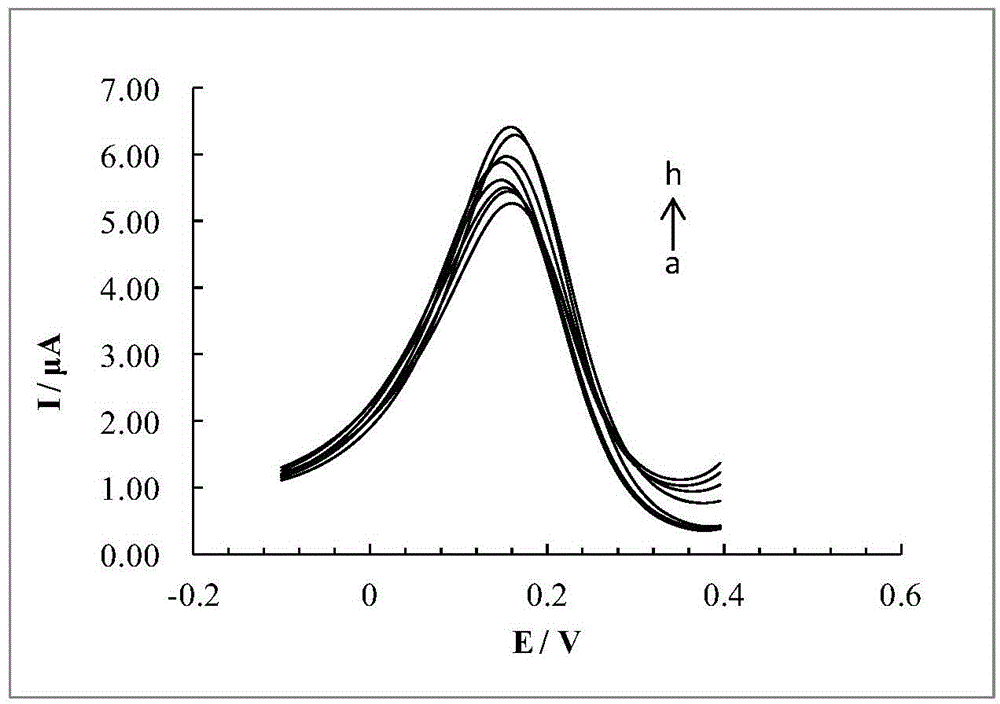PBP-1A affinity beta-lactam antibiotic electrochemical biosensor, and making method and application thereof
A PBP-1A, biosensor technology, applied in the direction of material electrochemical variables, scientific instruments, instruments, etc., can solve the problems of difficulty in obtaining penicillin antibodies, influence of detection efficiency, and no disclosure of antibiotic electrochemical biosensors, etc., to reduce the detection limit. , low detection limit, the effect of improving analytical sensitivity
- Summary
- Abstract
- Description
- Claims
- Application Information
AI Technical Summary
Problems solved by technology
Method used
Image
Examples
specific Embodiment 1
[0039] A PBP-1A affinity type β-lactam antibiotic electrochemical biosensor, the glassy carbon electrode is the working electrode, and the surface of the working electrode is modified with the nanomaterial graphene, the recognition element penicillin G and the binder nafion, as As for the detection carrier, the above-mentioned PBP-1A is penicillin-binding protein-1A derived from Streptococcus pneumoniae.
specific Embodiment 2
[0040] The preparation method of the PBP-1A affinity type β-lactam antibiotic electrochemical biosensor of the above-mentioned embodiment 1, the experimental materials are glassy carbon electrodes, Al 2 o 3 The powder, suede and glass plate, iron stand, and electrochemical analyzer were purchased from Shanghai Chenhua Instrument Co., Ltd., absolute ethanol, Na 2 HPO 4 , NaH 2 PO 4 etc. are analytically pure from Shanghai Sinopharm. Deionized water was prepared in the laboratory. Specifically include the following steps:
[0041] (1) Polishing and cleaning of the bare electrode: the glassy carbon electrode is sequentially cleaned with Al 2 o 3 The powder was polished into a mirror surface, and then ultrasonically cleaned with absolute ethanol and deionized water for 5 minutes respectively; after the peak voltage difference was detected by cyclic voltammetry to be less than 80mV, the electrode surface was rinsed with PBS solution with a pH of 7.4, and dried;
[0042] (2...
specific Embodiment 3
[0052] The sensitivity and linear range of the PBP-1A affinity type β-lactam antibiotic electrochemical biosensor to β-lactam antibiotics, the specific steps are as follows:
[0053] (1) Polishing and cleaning of the bare electrode: the glassy carbon electrode is sequentially cleaned with Al 2 o 3 The powder was ground into a mirror surface, and then ultrasonically cleaned with absolute ethanol and deionized water for 5 minutes respectively (ultrasonic cleaner, Kunshan Shumei KQ3200E); an electrochemical analyzer (Shanghai Chenhua CHI852c) was used for cyclic voltammetry (CV method) ) After detecting the peak voltage difference 2 blow dry;
[0054] (2) Activation of the bare electrode: place the glassy carbon electrode obtained in step (1) in a 1mol / L sulfuric acid solution, and scan for 10 cycles by CV method until it is stable;
[0055] (3) Modification of the bare electrode: Add 4 μL of 2.5 mg / mL nanomaterial graphene and 2 μL of 0.2 g / L recognition element penicillin G...
PUM
 Login to View More
Login to View More Abstract
Description
Claims
Application Information
 Login to View More
Login to View More - R&D
- Intellectual Property
- Life Sciences
- Materials
- Tech Scout
- Unparalleled Data Quality
- Higher Quality Content
- 60% Fewer Hallucinations
Browse by: Latest US Patents, China's latest patents, Technical Efficacy Thesaurus, Application Domain, Technology Topic, Popular Technical Reports.
© 2025 PatSnap. All rights reserved.Legal|Privacy policy|Modern Slavery Act Transparency Statement|Sitemap|About US| Contact US: help@patsnap.com



